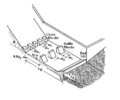Spillway facts for kids
A spillway is like a safety valve for a dam. It's a special part of a dam that helps release extra water safely. Imagine a giant bathtub that's getting too full. A spillway makes sure the extra water can flow out without causing any problems or damage to the dam or areas downstream.
Contents
What is a Spillway?
A spillway is a structure built into or next to a dam. Its main job is to let out water that the dam can't hold anymore. Dams are built to store water for many uses, like drinking water, farming, or making electricity. But sometimes there's too much water, especially after heavy rains or snowmelt.
Why Do Dams Need Spillways?
Every dam has a maximum amount of water it can safely hold. If the water level goes above this limit, it could put too much pressure on the dam. This could cause the dam to break, leading to dangerous floods. A spillway prevents this by letting the extra water flow away in a controlled way. This keeps the dam strong and protects people and places downstream from floods.
How Do Spillways Work?
When the water in a dam's reservoir gets too high, it flows into the spillway. The spillway then guides this water away from the dam. It often sends the water into a river or another safe area below the dam. This process helps keep the water level in the reservoir at a safe height.
Different Kinds of Spillways
There are several types of spillways, each designed for different situations:
- Overflow Spillways: These are common and look like a giant waterfall over a part of the dam. The water simply flows over the top edge.
- Chute Spillways: These are like a long, steep slide or channel. Water flows down this channel away from the dam. Some even have steps to slow the water down.
- Bell-Mouth Spillways: These look like a giant funnel or drain in the middle of the reservoir. Water flows into the "bell" and then down a shaft or tunnel.
- Labyrinth Spillways: These have a zigzag or wavy shape. This design makes the spillway longer in a small space, allowing more water to flow out.
- Emergency Spillways: Some dams have these as a backup. They are usually just a natural channel or a simple opening that only gets used in extreme flood events.
Keeping Dams Safe
Spillways are a very important part of dam safety. They help manage water levels and prevent disasters. Engineers carefully design spillways to handle the largest possible floods. This ensures that dams can continue to provide benefits like water supply and power, while also protecting communities.
Gallery
Images for kids
-
A stepped chute baffled spillway of the Yeoman Hey Reservoir in the Peak District in England.
-
A labyrinth spillway and a fish ladder (left) of the Hope Mills Dam in North Carolina
-
Spillway with flip bucket at Burdekin Dam
-
Water enters Hoover Dam's Arizona side channel drum-gate spillway (left) during the 1983 floods
-
A labyrinth spillway entrance (bottom) at the Ute Dam in New Mexico
-
An ogee-type spillway at the Crystal Dam in Colorado
-
An emergency spillway with fuse plug (bottom) and an auxiliary ogee spillway (top) at New Waddell Dam
-
Semicircular spillways of Ohzuchi Dam (Shiga Pref., Japan)
-
Low-height spillway of Bonneville Dam with sluice gates
-
A drop inlet in use at Horse Mesa Dam in Arizona, circa 1940




















